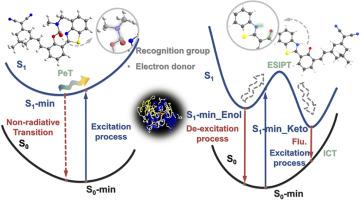Unraveling the Multi-sensing mechanism of 2-(2′-Hydroxyphenyl)-benzothiazole fluorescent probes for acetylcholinesterase detection
Abstract
The efficient design of dual-sensing mechanisms for fluorescent probes holds significant implications for real-time monitoring of acetylcholinesterase (AChE) under oxidative stress. In this study, we employed density functional theory (DFT) and time-dependent density functional theory (TD-DFT) to investigate the fluorescence detection mechanisms of 2-(2-hydroxyphenyl)benzothiazole derivatives SNCN-AE and SNC-AE. We proposed a fluorescence detection method based on the mechanisms of excited-state intramolecular proton transfer (ESIPT) and photo-induced electron transfer (PeT). Computational results indicate that the fluorescence quenching of SNCN-AE and SNC-AE results from the typical PeT process initiated by the dimethyl carbamate ester moiety. Upon reaction with the AChE, the electron donor is replaced by the hydroxyl group, and the PeT is suppressed. The redshift of emission wavelength arises from the ESIPT process rather than the ICT mechanism, as evidenced by the absence of charge transfer phenomena in the computed frontier molecular orbitals. This study provides a novel insight for the further development of fluorescence probes in the field of biomedicine, based on the PeT-ESIPT mechanism regulation.


 求助内容:
求助内容: 应助结果提醒方式:
应助结果提醒方式:


